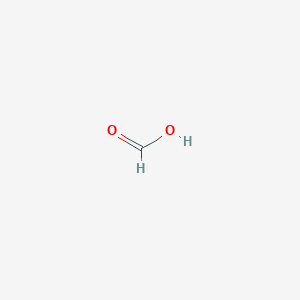| Synonyms |
Click to Show/Hide Synonyms of This Metabolite
Acide formique; Add-F; Aluminum formate; Ameisensaeure; Ameisensaure; Aminate; Aminic acid; Ammonium formate; Ammonium tetraformate; Bilorin; Calcium formate; Chromic formate; Cobalt(II) formate dihydrate; Cobaltous formate; Cupric formate; Formate; Formic acid, 14C-labeled; Formic acid, aluminum salt; Formic acid, ammonium (2:1) salt; Formic acid, ammonium (4:1) salt; Formic acid, ammonium salt; Formic acid, cadmium salt; Formic acid, calcium salt; Formic acid, cesium salt; Formic acid, cobalt (+2) salt; Formic acid, copper (+2) salt; Formic acid, copper salt; Formic acid, copper, ammonium salt; Formic acid, copper, nickel salt; Formic acid, cromium (+3) salt; Formic acid, cromium (+3), sodium (4:1:1) salt; Formic acid, lead (+2) salt; Formic acid, lead salt; Formic acid, lithium salt; Formic acid, magnesium salt; Formic acid, nickel (+2) salt; Formic acid, nickel salt; Formic acid, potassium salt; Formic acid, rubidium salt; Formic acid, sodium salt; Formic acid, sodium salt, 13C-labeled; Formic acid, sodium salt, 14C-labeled; Formic acid, strontium salt; Formic acid, thallium (+1) salt; Formic acid, zinc salt; Formira; Formisoton; Formylate; Formylic acid; H-COOH; HCO2H; HCOOH; Hydrogen carboxylate; Hydrogen carboxylic acid; Lead formate; Lithium formate; Mafusol; Magnesium formate; Methanoate; Methanoic acid; Methanoic acid monomer; Methoate; Methoic acid; Myrmicyl; Nickel formate; Nickel formate dihydrate; Potassium formate; Sodium formate; Strontium formate; Sybest; Wonderbond hardener m 600l; Zinc formate; collo-Bueglatt; collo-Didax
|
 click to show the details of this protein
click to show the details of this protein
 click to show the details of experiment for validating this pair
click to show the details of experiment for validating this pair

